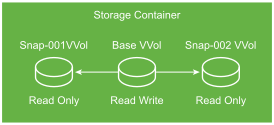Snapshots preserve the state and data of a virtual machine at the time you take the snapshot. Snapshots are useful when you must revert repeatedly to the same virtual machine state, but you do not want to create multiple virtual machines. Virtual volumes snapshots serve many purposes. You can use them to create a quiesced copy for backup or archival purposes, or to create a test and rollback environment for applications. You can also use them to provision application images instantly.
In Virtual Volumes environment, snapshots are managed by ESXi and vCenter Server, but are performed by the storage array.
Each snapshot creates an extra virtual volume object, snapshot, or memory, virtual volume, that holds the contents of virtual machine memory. Original VM data is copied to this object, and it remains read-only, which prevents the guest operating system from writing to snapshot. You cannot resize the snapshot virtual volume. And it can be read only when the VM is reverted to a snapshot. Typically, when you replicate the VM, its snapshot virtual volume is also replicated.

The base virtual volume remains active, or read-write. When another snapshot is created, it preserves the new state and data of the virtual machine at the time you take the snapshot.
Deleting snapshots leaves the base virtual volume that represents the most current state of the virtual machine. Snapshot virtual volumes are discarded. Unlike snapshots on the traditional datastores, virtual volumes snapshots do not need to commit their contents to the base virtual volume.

For information about creating and managing snapshots, see the vSphere Virtual Machine Administration documentation.